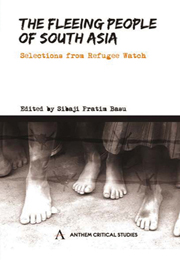Book contents
- Frontmatter
- Contents
- Acronyms and Abbreviations
- Foreword by Ranabir Samaddar
- Preface
- ETHICAL ISSUES
- LAWS
- SOUTH ASIA
- INDIA
- GENDER
- Introduction
- Refugee Repatriation: A Politics of Gender
- Families, Displacement, Partition
- Widows of Brindaban: Memories of Partition
- Agony Continues: Refugee Women of Bhutan
- Dislocating Women and Making the Nation
- Geder, Media and the Tsunami
- Why Should we Listen to Her?
- Women, Trafficking and Statelessness
- The Bar Dancer and the Trafficking Migrant: Globalization and Subaltern Existence
- INTERVIEW/CORRESPONDENCE
- REPRESENTATIONS
- Index
Families, Displacement, Partition
from GENDER
Published online by Cambridge University Press: 05 March 2012
- Frontmatter
- Contents
- Acronyms and Abbreviations
- Foreword by Ranabir Samaddar
- Preface
- ETHICAL ISSUES
- LAWS
- SOUTH ASIA
- INDIA
- GENDER
- Introduction
- Refugee Repatriation: A Politics of Gender
- Families, Displacement, Partition
- Widows of Brindaban: Memories of Partition
- Agony Continues: Refugee Women of Bhutan
- Dislocating Women and Making the Nation
- Geder, Media and the Tsunami
- Why Should we Listen to Her?
- Women, Trafficking and Statelessness
- The Bar Dancer and the Trafficking Migrant: Globalization and Subaltern Existence
- INTERVIEW/CORRESPONDENCE
- REPRESENTATIONS
- Index
Summary
FEAR, MEMORY AND THE CONTEXT
There has been a tendency to focus on the communal and violent nature of partition and the mass exodus accompanying it. This has been more the case of the Punjab frontier where forced migration took place on a large scale. Along the Bengal border things were different. For some families it was a matter of conscious choice. For example, this was a choice for families whose members were in government service and who were given an option to take equivalent work on the other side. It is mentioned by some families, however that often one had to decide in a very short period of time, so that people who took the option also had to reach a hurried decision and later regretted it. For others, the decision to migrate was taken almost overnight, especially if the family was directly or indirectly hit by a communal carnage that succeeded the partition. But for most families the decision to migrate was deliberated slowly and in waves within the circles of the family a process that continues even today. This created a curious effect on the social makeup of the region resulting in a diaspora of families. Hindus, Muslims, Biharis, Chakmas, Garos, etc, separated and divided, living on either side of the lines chalked out by the Radcliffe Award, each part engrossed in its own struggle for survival or achievement and yet still connected to each other by ties, emotional, imaginary and real. […]
- Type
- Chapter
- Information
- The Fleeing People of South AsiaSelections from Refugee Watch, pp. 304 - 310Publisher: Anthem PressPrint publication year: 2009



